Consultation with Ministers and Regional Ministers
Contents of this page:
Introduction to this chapter
In this chapter we present the results and analysis of the survey of Ministers and Regional Ministers.
The 63% response rate to a survey is a very good level of response.
What is striking is that 93% of accredited ministers responded. This is a very high level of response and shows how committed this group were to participate in the consultation and how important it was to them to be heard within the consultation. The response rate demonstrates the importance of the question to accredited ministers.
In this chapter we analyse the responses to the following questions:
-
Do you think that a minister can be accredited by the Baptist Union of Great Britain if they are in a same-sex marriage?
-
Are you prepared to be in covenant with other accredited ministers who think differently about this matter?
Ministers were asked about the effect of keeping or removing the bracketed section of MR Rules, Appendix 3, Section 4.3 on their ministry, both missional (beyond the congregation) and pastoral (within the congregation).
At the end of the ministers’ survey respondents were asked to tick a box if they were a Regional Minister, which took them through to a final question concerning the effect of keeping or removing the bracketed section on the life of their Association.
On the next page we look at who took part and then we look at the response to the first two questions.
Who took part?
1,868 individuals took part in the Consultation, 63% of the possible 2,962.
93% of accredited ministers responded.
If the people who responded were a village of 100 people…
-
61 would be accredited ministers, 23 would be retired, and 15 would not be accredited;
-
51 would be ministers of congregations, 5 chaplains, 3 Ministers in Training;
-
21 would be female, and 79 male;
-
15 would be aged under 45, 51 between 45 and 64, and 34 would be aged 65 and over;
-
95 would be White, 3 would be Black, 1 Asian and 1 Mixed.
|
Please note that not all categories from the survey are listed here and not all respondents answered these questions, therefore these totals may not add up to 100. |
Return to top of page
Questions about Accreditation and Same-Sex Marriage
In this section we present the ministers’ responses to these two questions:
-
Do you think that a minister can be accredited by the Baptist Union of Great Britain if they are in a same-sex marriage?
-
Are you prepared to be in covenant with other accredited ministers who think differently about this matter?
Initially we look at these results as a whole response. Then we look at responses through a number of different lenses, for example gender; accreditation/non-accreditation/retired; ethnicity. We explore what this approach to the data reveals about the responses to these questions. To what extent do ministers in different characteristics respond differently to the questions?
The survey asked ministers to respond to these two questions on a sliding scale, from ‘absolutely not’ to ‘definitely yes’. The position selected on the sliding scale was matched with a numerical score, from 0 for ‘absolutely not’, to 10 for ‘definitely yes’. In the pie charts that follow we have aggregated the scores to give three categories: 0-2 is ‘no’, 3-7 is ‘neutral’ and 8-10 is ‘yes’. For completion we have also shown the number of abstentions.
If you are interested to
look in more detail at the data, see the Appendices.
What did they say?
Do you think that a minister can be accredited by the Baptist Union of Great Britain if they are in a same-sex marriage?
|
|
Are you prepared to be in covenant with other accredited ministers who think differently about this matter?
|
 |
|
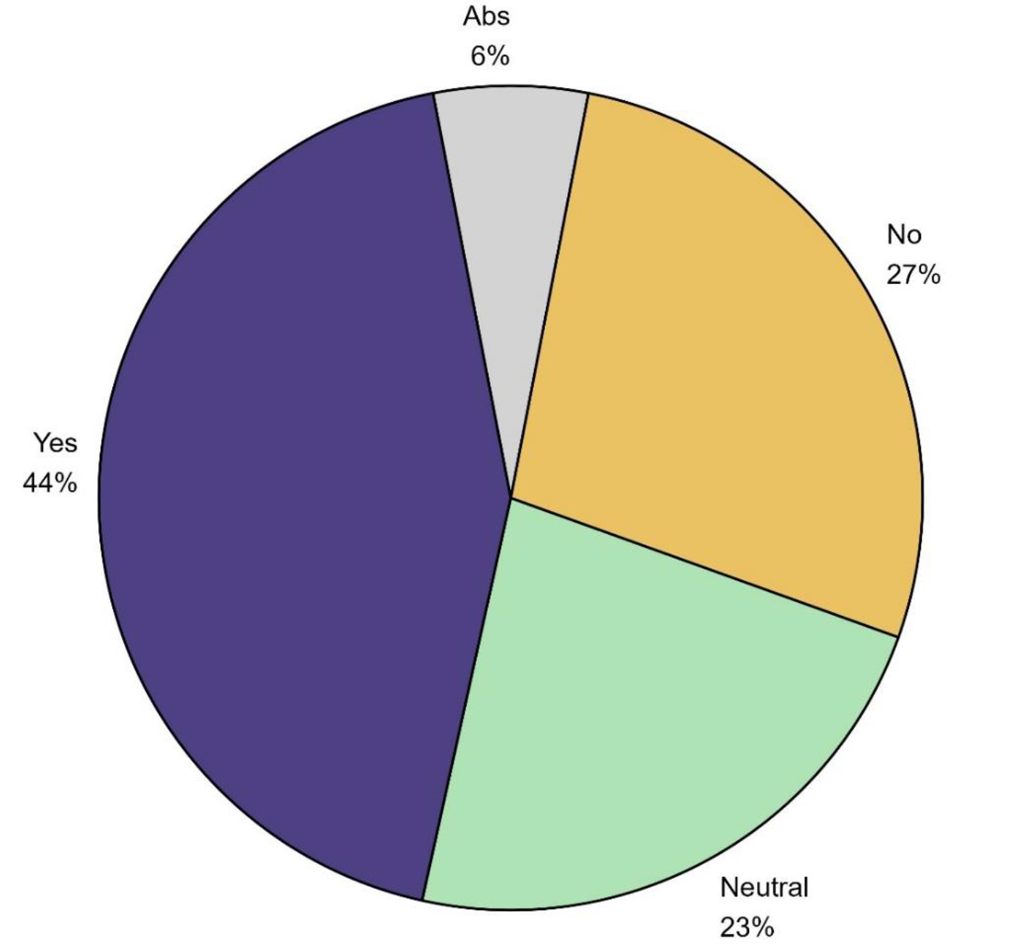 |
57% of those who responded said that an accredited minister could not be in a same-sex marriage; 25% said they could be. 15% were neutral and 4% abstained. |
|
27% of those who responded said that they could not stay in covenant with those who have a different opinion; 44% said they could stay. 23% were neutral and 6% abstained.
|
Headlines from these charts
57% of ministers who responded to the survey say that ministers in a same-sex marriage could not be accredited. However, the responses show that 27% of ministers said they could not stay in a covenant relationship with accredited ministers who have a different view, whilst 44% said they could.
A note about neutral responses
The neutral responses (scores of 3-7) are reasonably high as a proportion of all responses. This may indicate any number of reasons: it may be the minister is undecided; it may be that they are unconcerned; it may be the minister wants to hold a middle place between yes and no. There may be other reasons for a neutral score. The data does not enable us to be conclusive about the reasons.
A note about abstentions
Only 4% of ministers who responded abstained for the accreditation question and 6% abstained from the question about covenant relationship. This is very low. There may be a variety of reasons why ministers abstained from answering one or both of these questions. They may be unclear in their own mind; they may not think it appropriate for BUGB to ask the question. There may be other reasons for abstaining. It is not clear from the data why ministers abstained.
It is worth noting that fewer ministers in this survey abstained than churches in the church survey where the abstention rate was 18% for the first question and 20% for the second. This may be that ministers may be more likely to have given these questions thought; it may reflect that these questions can be complex to explore in church contexts, where there may be different views; it is more likely that a person will be of one-mind than a group of people are. There may be a range of other reasons why this number is different. Again, the data is not clear.
Understanding the charts
We will now look at the responses to these two questions through a variety of lenses. The purpose of this approach to the data is to identify what, if any, differences there are in the responses, depending on age, ethnicity, gender and other characteristics. This information was gathered from participants at the beginning of the survey. Occasionally ministers did not complete all the ‘demographic’ questions, however almost all did, and it is therefore useful when analysing the responses.
Who said what?
Each chart uses the following legend:

 |
|
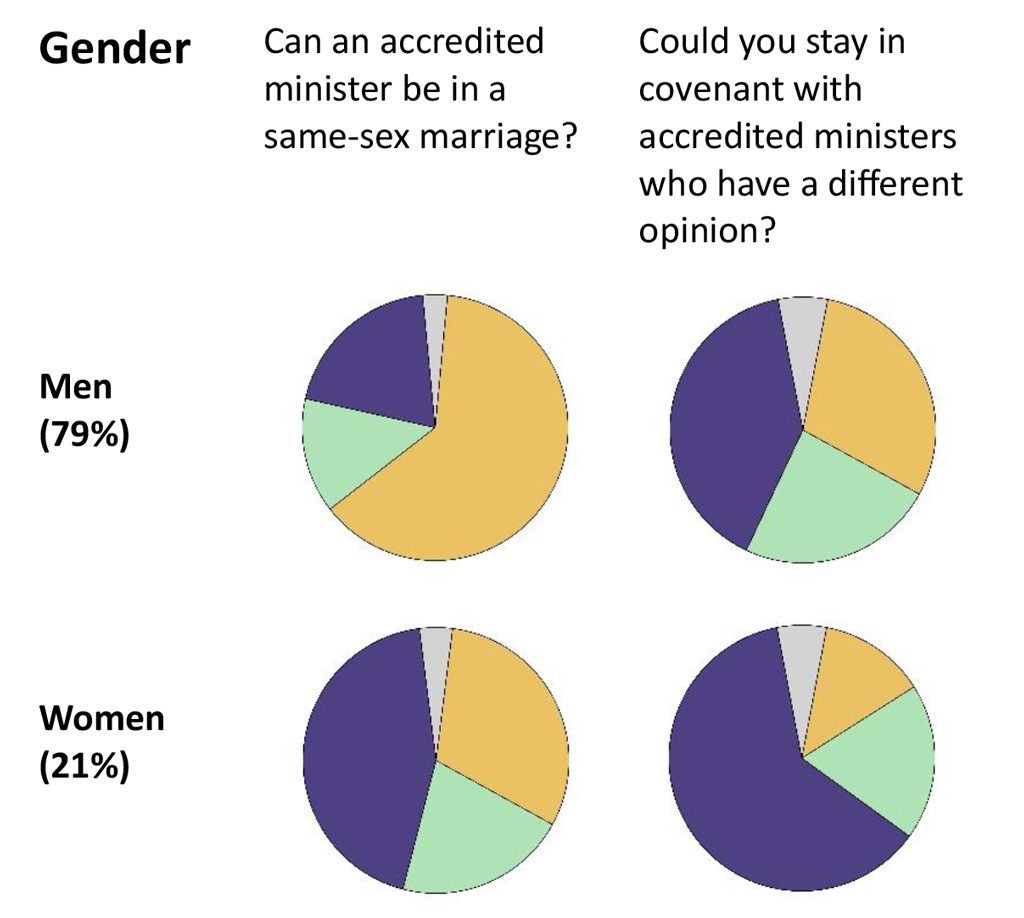 |
All categories of minister had a majority of respondents who felt that an accredited minister could not be in a same-sex marriage. Accredited ministers were most likely to remain in covenant with accredited ministers of a different opinion, followed by retired ministers and non-accredited ministers.
|
|
Please note: 0.1% of respondents said that they had another gender. Responses from fewer than 10 people are not shown for their privacy.
44% of women who responded thought that accredited ministers could be in same-sex marriages compared with 20% of men who responded. 62% of women felt that they could stay in covenant with accredited ministers of a different opinion, in comparison with 40% of men.
|
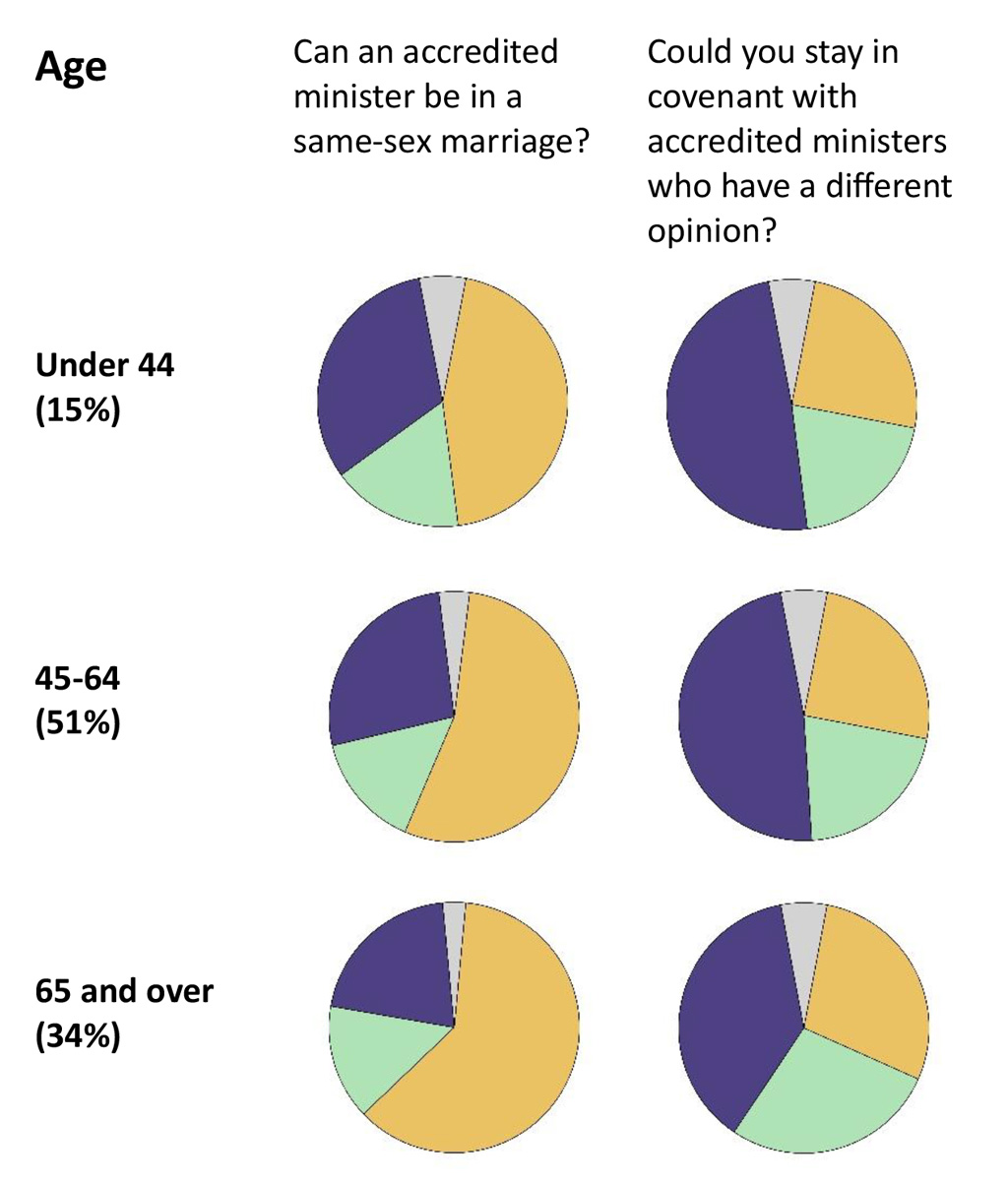 |
|
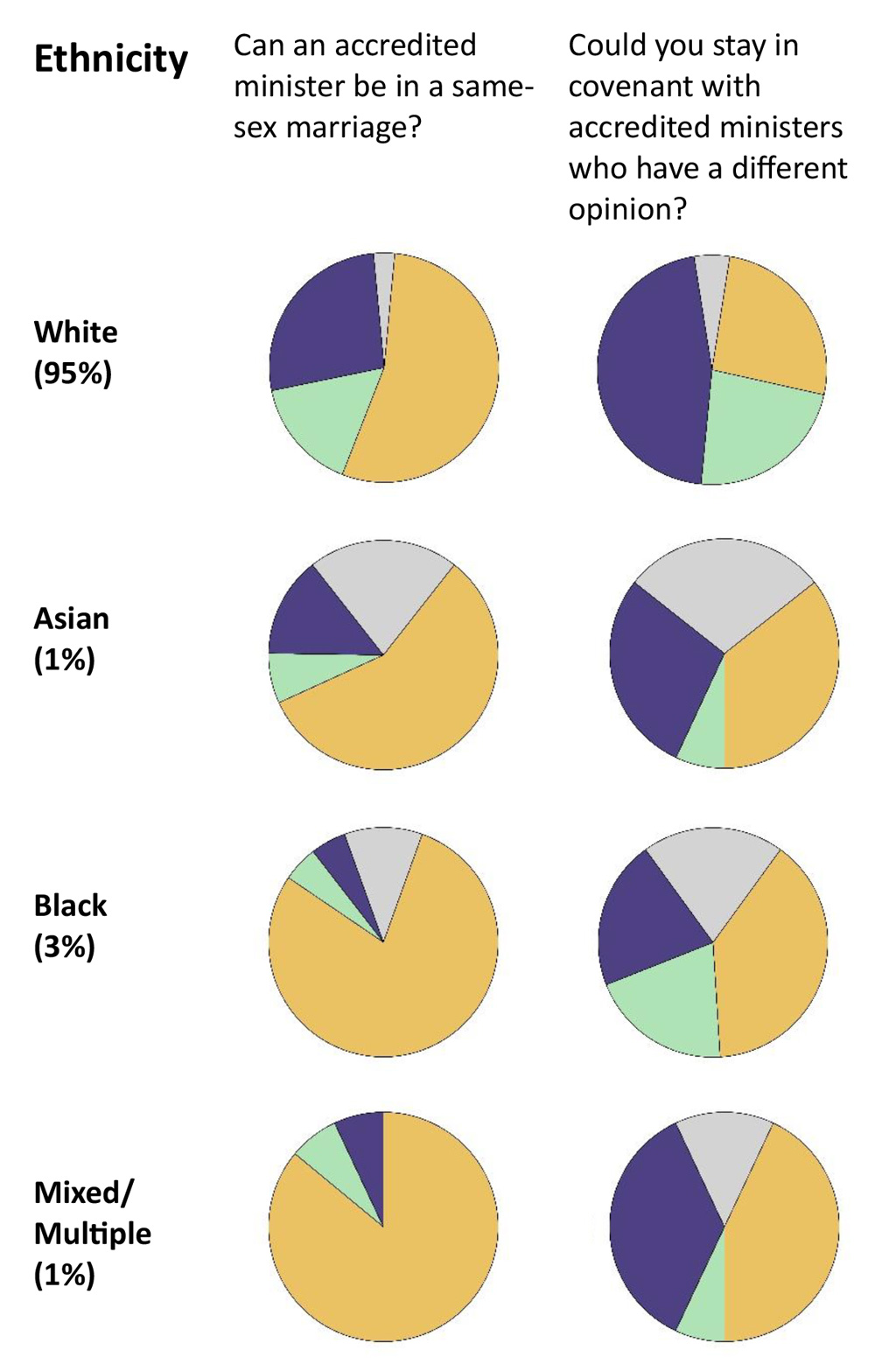 |
Younger ministers who responded were more likely to say that accredited ministers could be in a same-sex marriage and to stay in covenant with accredited ministers of a different opinion.
|
|
White ministers who responded were most likely to say that accredited ministers could be in a same-sex marriage and to stay in covenant with accredited ministers of a different opinion. Black ministers who responded were least likely to agree with both statements.
|
Headlines from these charts
57% of ministers who responded say that ministers in a same-sex marriage could not be accredited. 44% of ministers said they could stay in covenant relationship with accredited ministers who have a different opinion.
The charts show that for nearly all the characteristics a majority of ministers felt that an accredited minister could not be in a same-sex marriage. There were two exceptions to this: i) women, where 31% felt that an accredited minister could not be in a same-sex marriage and ii) ministers aged under 44, where 45% felt this.
Whilst 52% of accredited ministers say that ministers in a same-sex marriage could not be accredited, 50% could stay in covenant relationship with accredited ministers who have a different opinion. Furthermore, 62% of women who are ministers say they could stay in relationship with accredited ministers who have a different opinion. 49% of ministers under 44 and 48% of ministers between 45-64 said they could stay in relationship with accredited ministers who have a different opinion.
More ministers who responded who are black (79%), Asian (57%) or mixed/multiple (86%) have said a minister could not be accredited than white ministers (55%). Similarly, more ministers who are black (39%) Asian (36%) or mixed/multiple (43%) have said they could not stay in relationship with accredited ministers who hold a different view, than white ministers (26%). BUGB does not hold ethnicity data on ministers, so we are unable to say what proportion of ministers within each ethnicity option responded.
If you want to look at this survey data in more detail, it is in the Appendices.
Return to top of page
Questions about the effect of removing or retaining the bracketed section on missional and pastoral life.
Ministers were asked about the effect of keeping or removing the bracketed section of MR Rules, Appendix 3, Section 4.3 on their ministry, both missional (beyond the congregation) and pastoral (within the congregation).
Ministers were asked:
-
In your view if BUGB were to decide to retain the section in brackets, what effect would this have on your missional ministry?
-
In your view if BUGB were to decide to remove the section in brackets, what effect would this have on your pastoral ministry?
The survey questions asked people to respond on a sliding scale, from ‘very negative’ to ‘very positive’. The position on the sliding scale matched to the numbers 0-10. When a minister selected a place on the sliding scale, that place had a corresponding number, where 0 was ‘very negative’ and 10 was ‘very positive’. In the bar charts that follow we have aggregated the scores to give three categories: 0-2 is ‘positive’, 3-7 is ‘neutral’ and 8-10 is ‘yes’.
The results are shown in bar charts to reflect the sliding scale from ‘very positive’ to ‘very negative’.
We have presented the ‘keep’ the bracketed section results first, looking at the effect on the minister’s missional ministry and then looking at the effect on their pastoral ministry.
Then we have presented the ‘remove’ the bracketed section, looking at the effect on the minister’s missional ministry and then on their pastoral ministry.
For clarity, the percentages shown in the charts do not include abstentions. They were around 9% of the ministers’ responses.
What did they say?
Ministers were asked about the effect of
keeping or
removing the bracketed section of MR Rules, Appendix 3, Section 4.3 on their ministry, both missional (beyond the congregation) and pastoral (within the congregation).
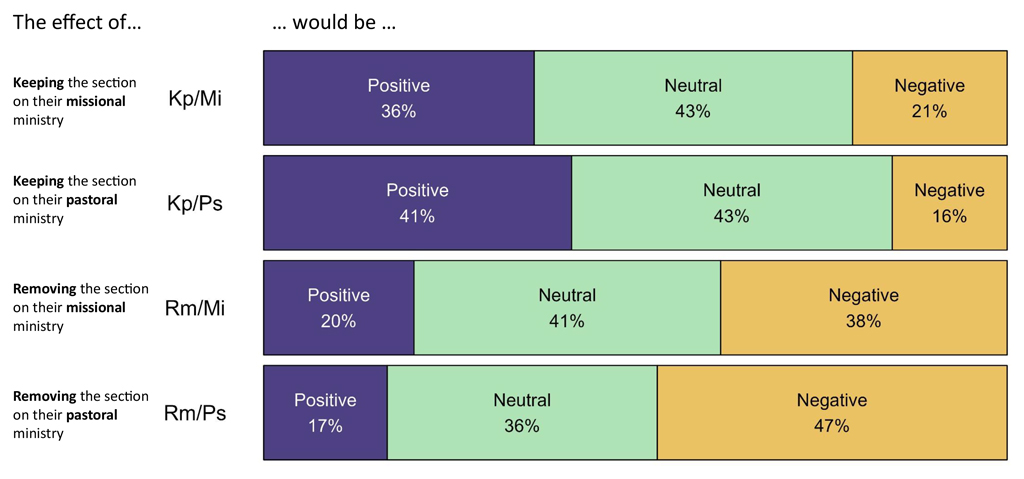
Ministers who responded felt that
keeping the bracketed section would be
positive for both their
missional (Kp/Mi: 36%) and pastoral
(Kp/Ps: 41%) ministries. One in five (21%) thought that keeping the bracketed section would be negative for their missional ministry.
Removing the bracketed section would have a
negative effect on ministers’
missional (Rm/Mi: 38%) and
pastoral (Rm/Ps: 47%) ministries.
Understanding the charts
In both missional and pastoral life more ministers felt that
keeping the bracketed section would have a positive effect than
removing it. More ministers felt that
removing the bracketed section would have a negative effect on their missional and pastoral ministry than
keeping it. It is notable that in response to three out of four of the questions more ministers gave a neutral response to the questions, the exception being the effect of
removing the bracketed section on their pastoral ministry.
A note about neutrality
The neutral space in these bar charts is a place in the middle of the sliding scale between ‘very positive’ and ‘very negative’. There will be a range of reasons why ministers selected this part of the sliding scale. In some cases it may be because they recognise some positive and some negative effects of removing or keeping the bracketed section; it may be that they are unsure of the effects; it may be that they do not think there will be a significant effect either way. There may be a variety of other reasons why ministers selected the space in the middle. It is not clear from the survey data as to why they chose the neutral response.
We will now look in more detail at the responses from ministers to these questions about the effect on their missional and pastoral ministry of
keeping or
removing the bracketed section in the MR Rules. The purpose of this approach to the data is to identify what, if any, differences there are in the responses, depending on age, ethnicity, gender and other characteristics. This information was gathered from participants at the beginning of the survey. Occasionally ministers did not complete all these ‘demographic’ questions, however almost all did, and it is therefore useful when analysing the responses.
Who said what?
Each graph considers the effect of
Keeping (Kp) or
Removing (Rm) the bracketed section, on
Missional (Mi) and
Pastoral (Ps) ministries, and uses the following legend:

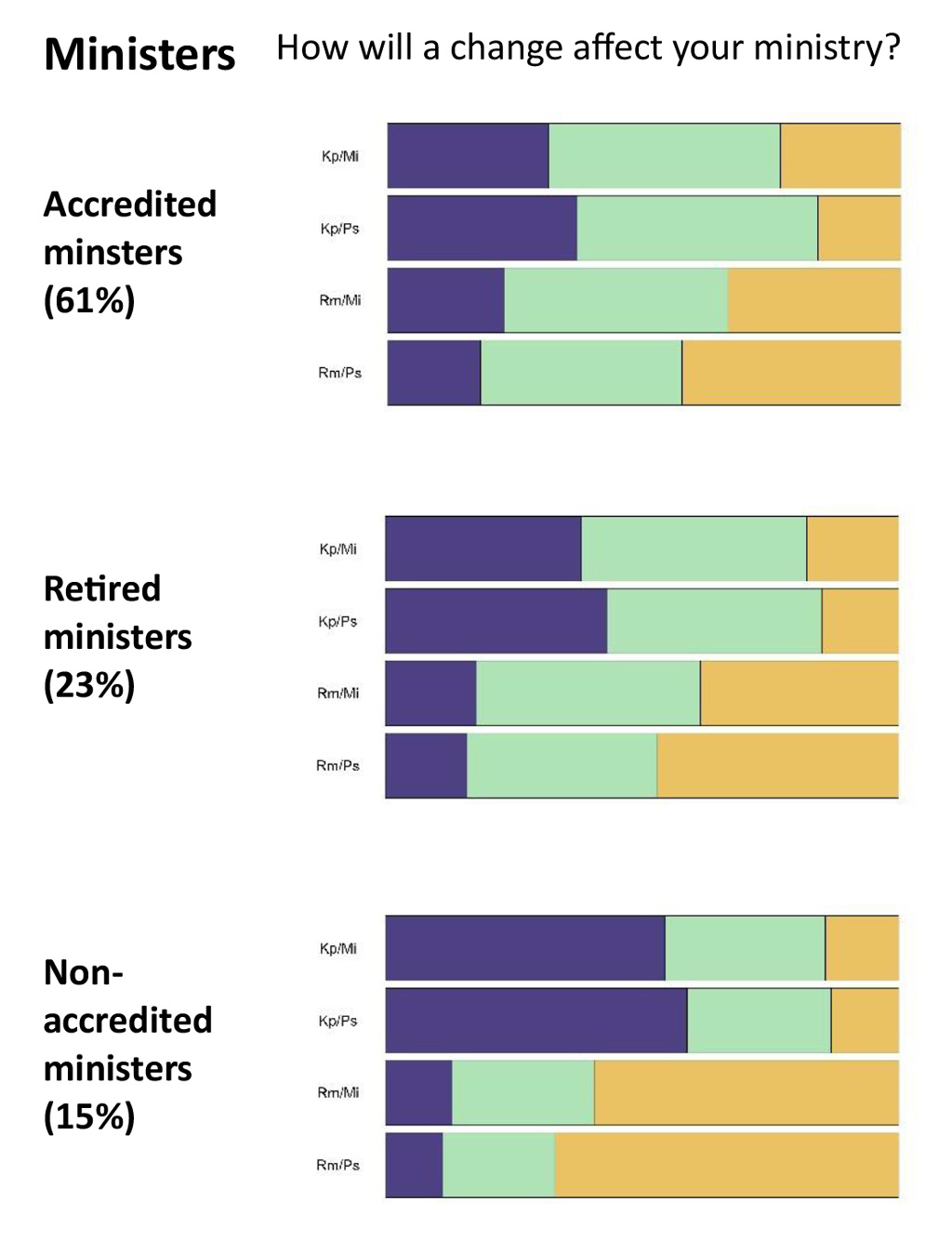 |
|
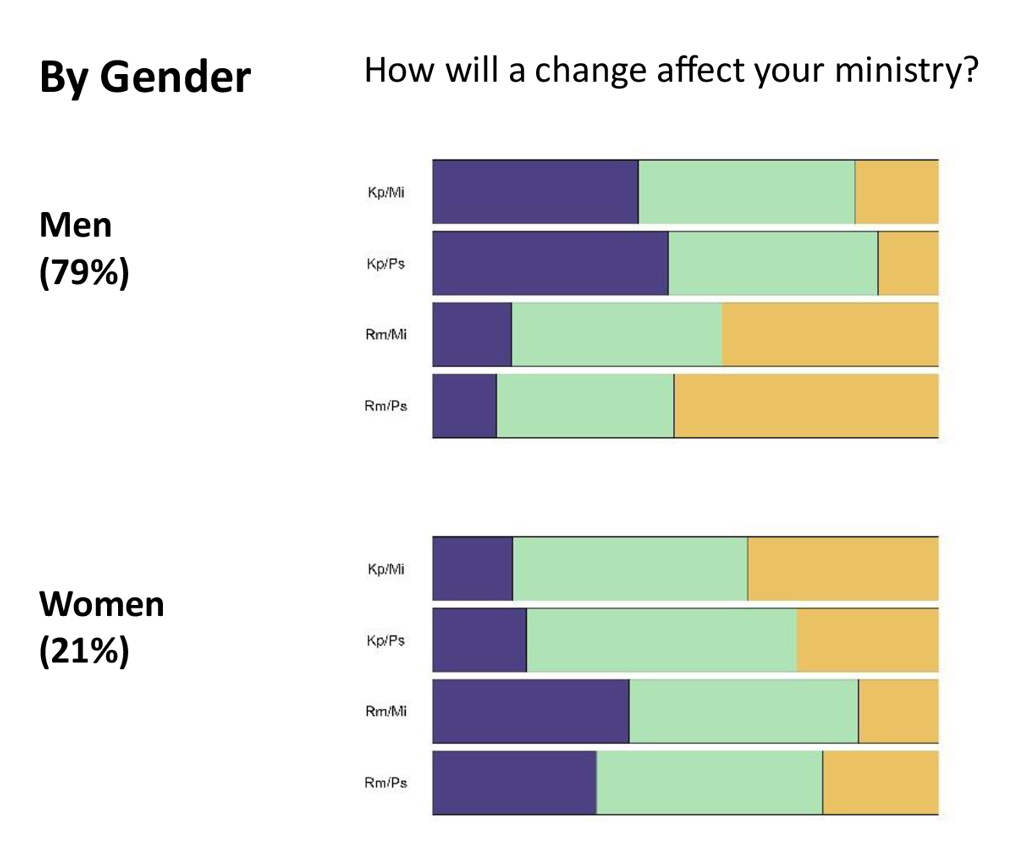 |
Non-accredited ministers who reponded were much more likely to think that keeping the bracketed section would be positive for their mission (54%) and pastoral (49%) ministries compared with accredited ministers (32% and 37%)
|
|
Women who responded were much more likely than men to think that removing the bracketed section would be beneficial for their missional and pastoral ministries.
|
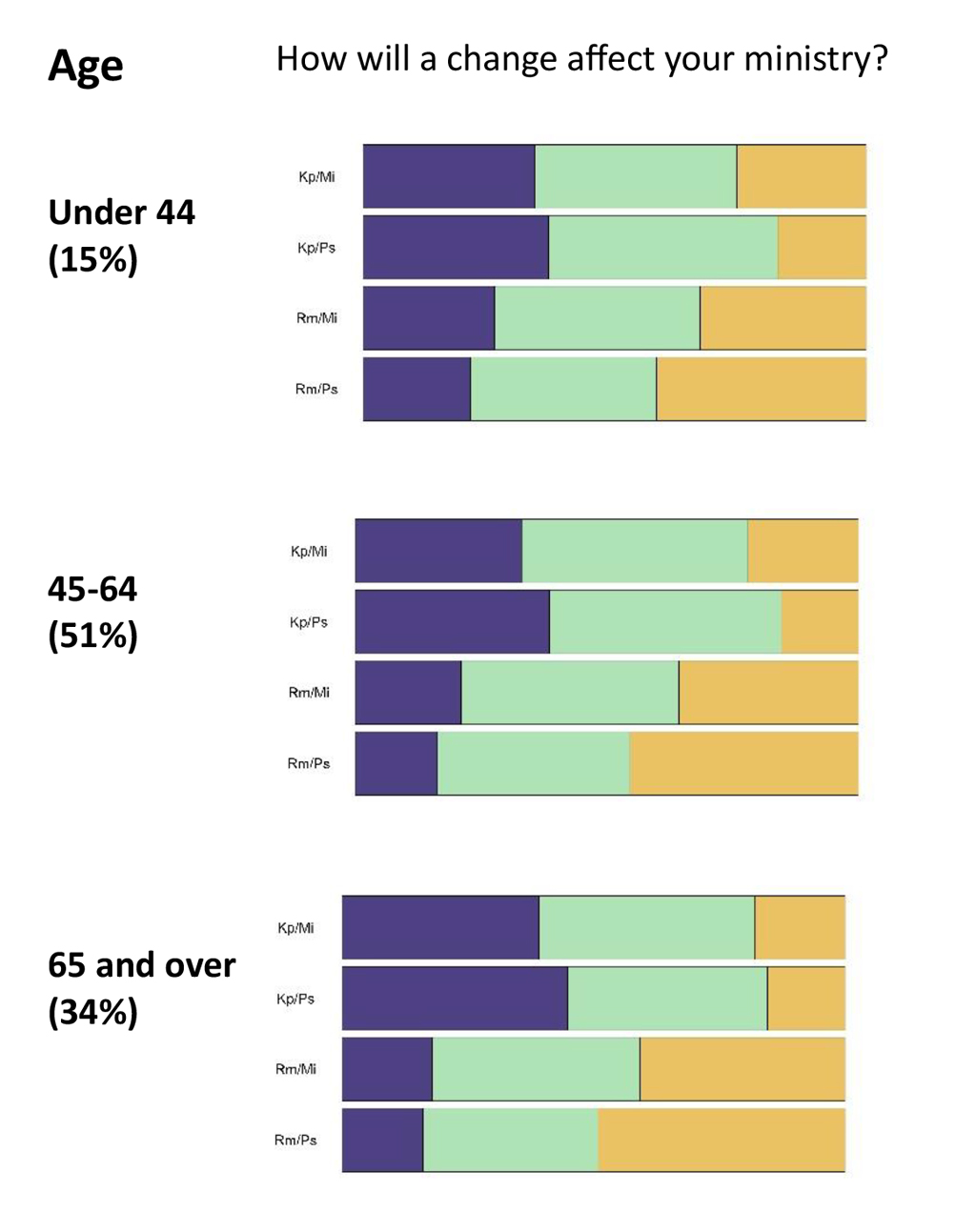 |
|
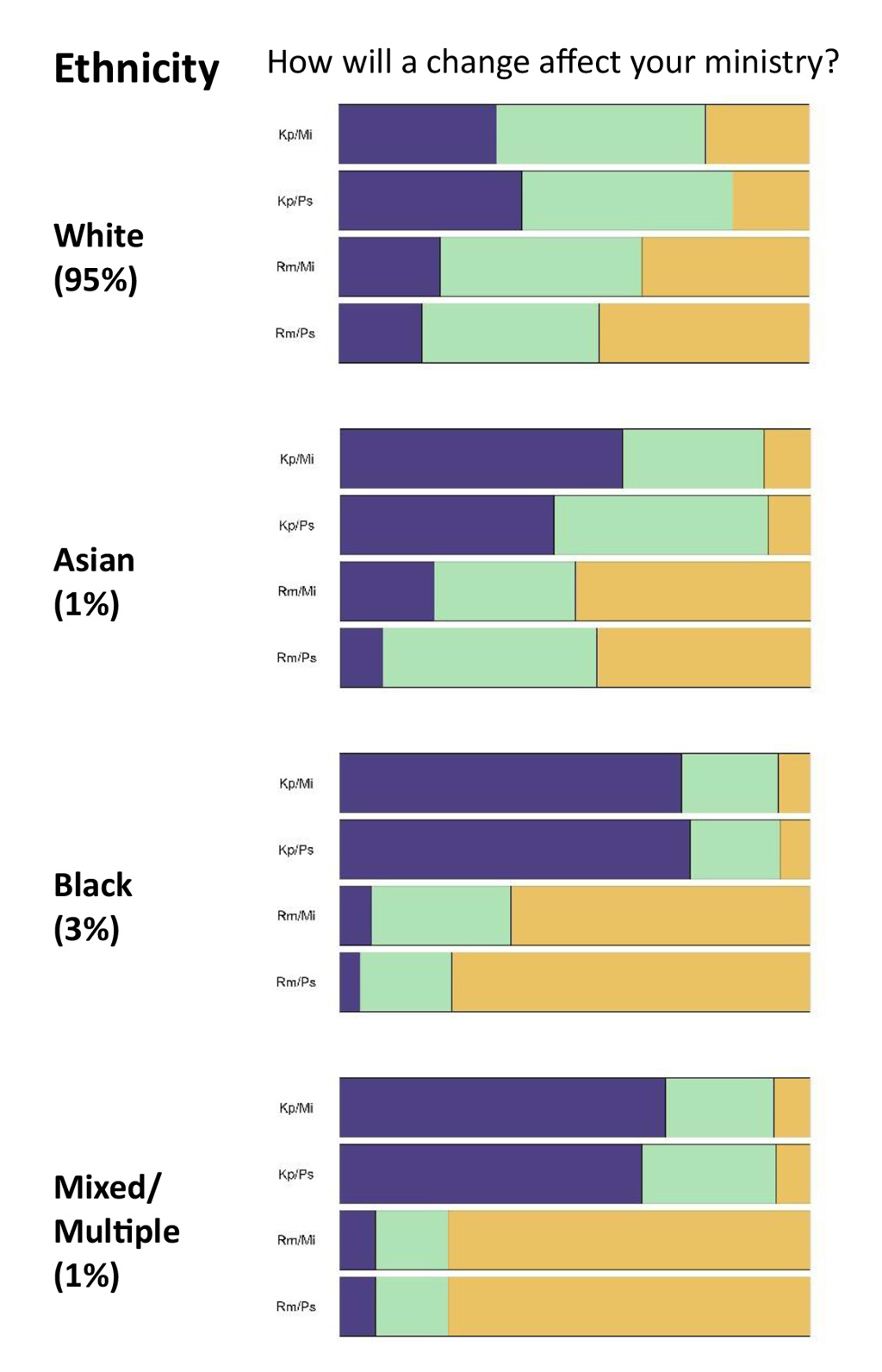 |
There is little difference between older and younger ministers who responded, although older ministers are slightly more positive about keeping the section (39%/45% as opposed to 33/34% in younger ministers).
|
|
Ministers of Global Majority Heritage who responded are much more positive about the effects of keeping the section (up to 75%) than white ministers (34%/40%).
|
Headlines from the charts
In all but one of the categories, more ministers felt that
keeping the bracketed section would have a greater positive impact than
removing the bracketed section. The exception is women who are considerably more likely than men to think that
removing the bracketed section would have a positive effect on their missional and pastoral ministries.
With the exception of women, more ministers in each category felt that the positive effect of
keeping the bracketed section outweighs the negative effect of
keeping that section in the MR Rules.
For GMH ministers the percentage who felt that
keeping the bracketed section would have a positive effect was almost always a considerable majority - missional (72% black, 60% Asian, 69% mixed/multiple) and pastoral (75%, 45% and 64%) ministry. By contrast, for ministers who selected white, this was 34% missional and 39% pastoral ministry.
A note about neutrals
As mentioned above, the neutral responses are often considerable, sometimes around 40%. There will be a range of reasons why ministers selected this part of the sliding scale. This may be because they recognise some positive and some negative effects of removing or keeping the bracketed section. It may be because they are unsure of the effects; it may be that they do not think there will be a significant effect either way. There may be a variety of other reasons why people selected these spaces in the middle. The data does not give insight into the neutral responses.
Following the questions about the effect of removing or keeping the bracketed section, respondents were invited to give their thoughts and comments. We have identified a handful of comments to illustrate some of the reasons why people responded as they did to these questions.
Pastoral effect
Two things are most striking about ministers’ responses:
i) concern about how a change would impact on their role as a leader and teacher in their church:
“If BUGB were to remove the section in brackets there might be some within my congregation who felt we should leave BUGB, and this would greatly impact upon my pastoral ministry … I would have to defend my personal view in my pastoral ministry, without the full support of the denomination/union who accredited me.”
“It would make pastoral ministry very difficult if, in counselling an orthodox biblical line sensitivity, it were to be undermined by the very denomination we are a part of.”
“If removed then it would put pressure on me to conform to a new social norm which I view unscriptural, if kept, then it would give confidence for me to stand up to that viewpoint.”
ii) concern about the effect on their congregation:
“It will bring confusion and uncertainty about the authenticity of the Bible and faith in God.”
“If ministers are no longer required to live by Biblical teaching, we have absolutely no right to expect our congregations to do so.”
There were some who outlined the positive effect of removing the bracketed section:
“Removing the section in brackets would mean that I could pastor with integrity, as it would mean that the church I love says all people are loved by God in Christ Jesus, regardless of sexuality.”
“We are causing huge damage to the LGBTIQ community. A decision needs to be made and I hope and pray it will be one that is inclusive and full of love.”
“I think it is time for the Union to grasp the nettle here, be bold and move forward in ending discrimination against gay brothers and sisters.”
Missional effect
Comments about the impact on missional ministry focused on:
i) the credibility and reputation of the church,
“It is dividing some congregations, so how can this be good for Gospel Ministry and the building of the church?”
“This [a decision to remove the bracketed section] will bring God’s wrath and will lead to the break-up of the BU and ultimately to a weak and ineffective Christian evangelical church in the UK.”
ii) understandings of biblical truth,
“There is a huge challenge about how to connect with a vastly changed world … but if we fail to honour the Word, we fail completely.”
”Once we turn our back on the authoritative word of God then we lose the power of God in our ministry and our ministry becomes just another social programme.”
“Both our pastoral and missional activity should not be determined by what is ‘easy’ or ‘difficult’ but by adherence to our biblical teaching.”
iii) a few ministers mentioned a concern for young people. Here is an illustrative quote.
“Retaining the brackets does damage to the reputation of the church and so is potentially detrimental to mission, especially among young people.”
Return to top of page
What is the effect on Association life?
At the end of the Minister’s survey respondents were asked if they were a Regional Minister. If they answered ‘yes’ this took them to additional questions. They were asked:
-
In your context, if BUGB were to decide to retain the section in brackets, what effect would this have on the life of your Association?
-
In your context, if BUGB were to decide to remove the section in brackets, what effect would this have on the life of your Association?
What did they say?
Regional Ministers were asked about the effect on the life of their Association of
keeping or
removing the bracketed section of MR Rules, Appendix 3, Section 4.3.

Just over one third (35%) of Regional Ministers who responded felt that
keeping the bracketed section would be
positive for the
life of their Association, and 8% thought that it would have a negative effect. No Regional Ministers who responded thought that
removing the bracketed section would be
positive for the
life of their Association, and 46% thought that it would have a
negative effect.
Headlines from the chart
It is immediately striking that none of the Regional Ministers felt that removing the bracketed section would have a positive effect on the life of their association. It is also notable that the majority chose neutral as their response.
We analysed the comments from the Regional Ministers:
-
A considerable number of Regional Ministers talked about concern that churches would leave the Union:
“Changes to the rules will mean that churches will leave the Association and Union and if they stay will reduce their giving.”
“I believe that we would have a number of churches who would vote to leave the Union and a number of ministers who would resign their accreditation.”
-
A number recognised that whichever decision is made there will be an impact:
“Support will be needed to those who feel that their view wasn’t ‘upheld’.”
“Whatever decision is made there will be people who are hurt.”
“Either way there will be people upset. The group who will be upset if it was removed will be larger, I suspect.”
-
Some spoke about how they were approaching the potential effect of the decision:
“We live with diversity, so I don’t think it would make much difference to association life.”
“There is a crucial need for love and compassion in discussing this issue and in working out the implications regardless of theological position in both ministerial and missionary practice.”
If you would like to see the
data from this chapter in more detail, it is in the Appendices.
Return to top of page
In the next chapter we will present the responses from the
Baptist Assembly Listening Space. This is followed by a chapter
exploring the themes that emerged in all that we have heard during the Consultation.